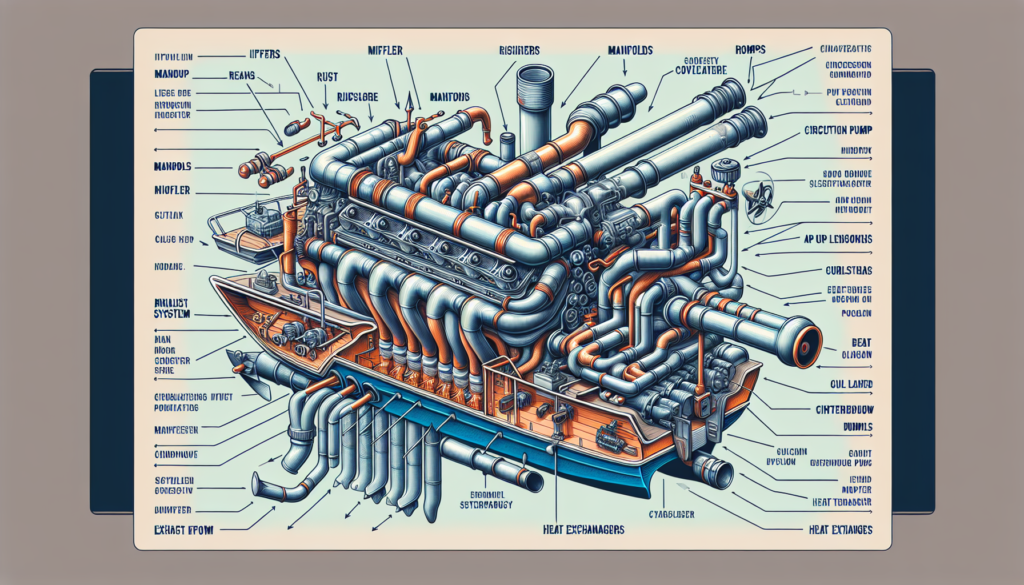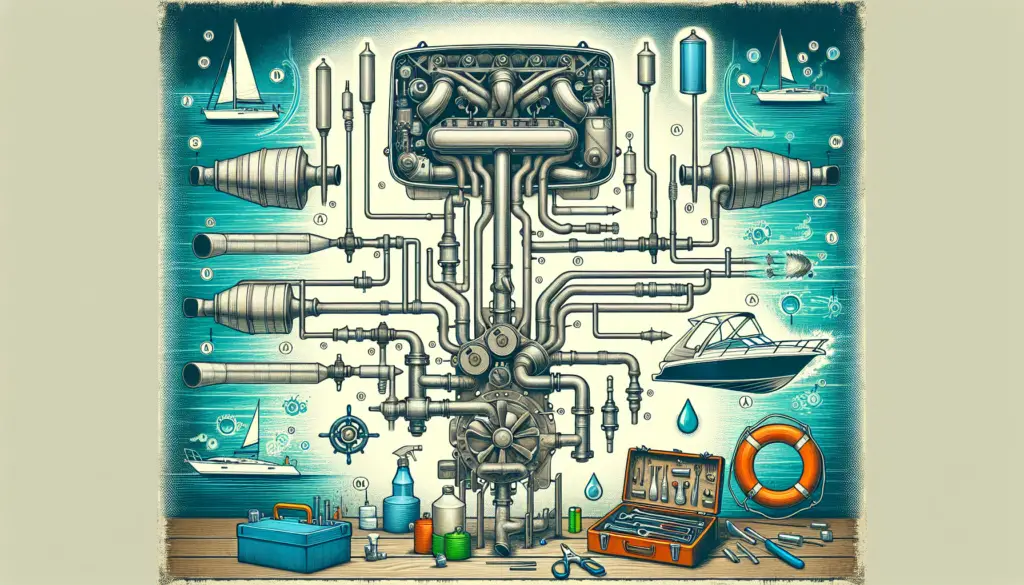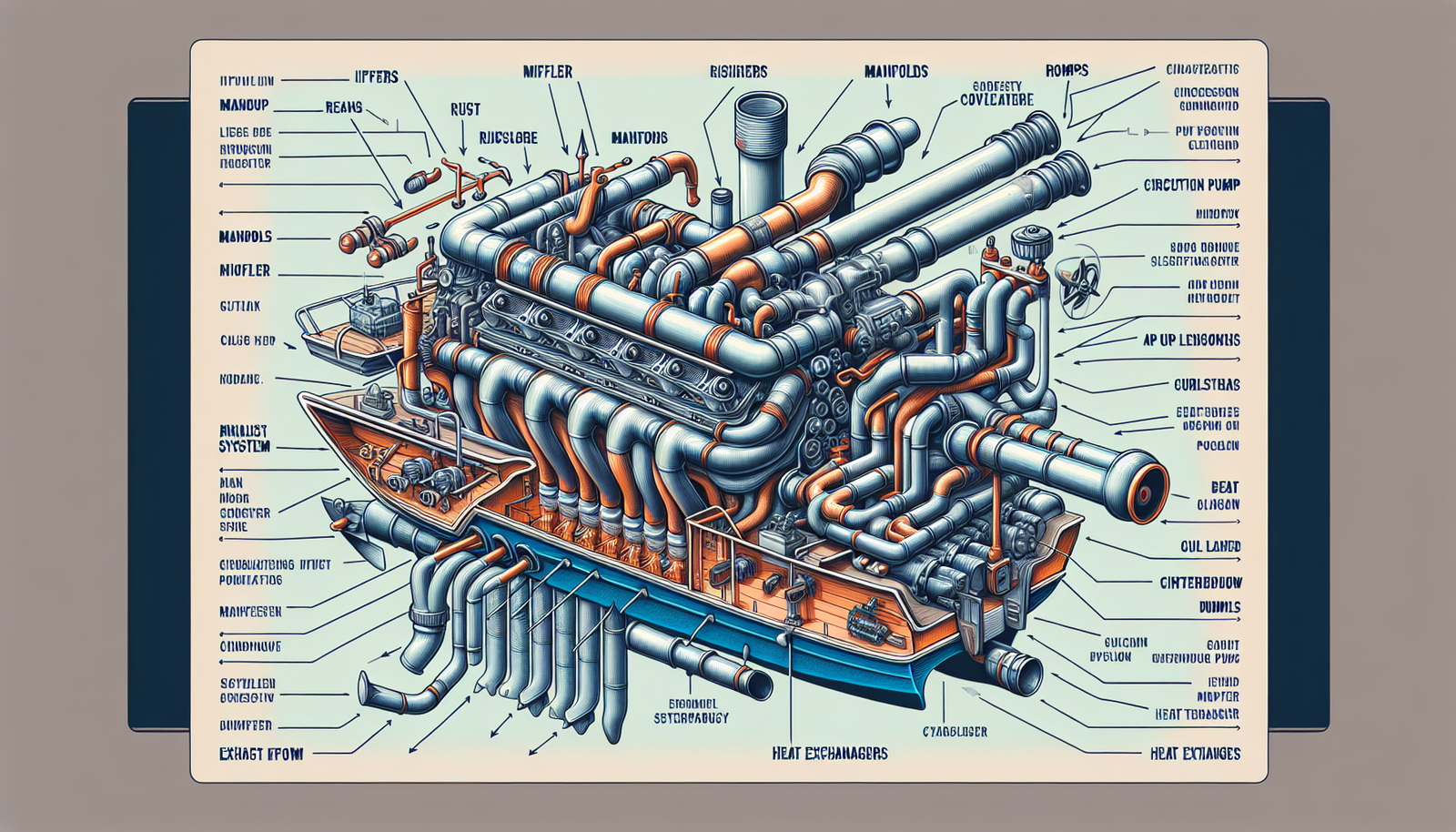You’re about to embark on a journey through the intricacies of boat engine exhaust systems. This is your essential guide that explains everything in an easily comprehensible style, turning abstract concepts into tangible knowledge. Whether you’re a seasoned mariner or making your debut on the water, this guide will enhance your understanding of what really happens when you rev up that engine. From the fine-tuning of the exhaust gas flow to managing the sound, temperature and vibrations, everything is laid bare. Prepare to be enlightened on how to properly maintain your nautical investment and keep it running smoothly.

Understanding the Purpose of Boat Engine Exhaust Systems
As a boat owner, you’ve probably tinkered around the engine, making sure everything’s in working order. But have you paid much attention to the boat engine exhaust system? This system plays a vital role in the proper functioning of your boat and understanding its purpose can be quite handy.
Role in expelling gases
First off, let’s take a look at its basic role which is the expulsion of gases. When your boat’s engine runs, it generates gases as part of the combustion process. These gases can be harmful and must be properly expelled. You can think of the exhaust system as the lungs of your boat, discarding the gases away and ensuring the engine operates smoothly.
Preventing backflow into engine
Another usage of a boat exhaust system is the prevention of backflow into the engine. The system is designed to let gases out, but also to prevent them from flowing back into the engine. Backflow can cause serious damage, such as water getting into the cylinders, which can lead to engine failure. That’s why it is critical to ensure your exhaust system is always in its prime condition.
Aid in cooling engine
Lastly, the boat engine exhaust system aids in cooling the engine. Some types of systems use water to cool down the hot gases before they’re expelled out. If the engine gets too hot, it can overheat and may need costly repairs. The exhaust system plays a key role in regulating the engine’s temperature and keeping it from overheating.
Different Types of Boat Engine Exhaust Systems
You might be surprised to learn there are several types of boat engine exhaust systems. Each type has unique advantages and is designed for different types of engines and vessels.
Wet exhaust systems
Wet exhaust systems are a popular choice for most small to medium-sized boats. These systems utilize water to cool exhaust gases before they are expelled. The water is then discharged with the exhaust gases, which also helps to muffle noise.
Dry exhaust systems
On the other hand, dry exhaust systems don’t use water for cooling. Instead, the exhaust gases are expelled straight away after being cooled by the air. These systems are mostly used on larger vessels, as they require more space due to the necessary insulation against the high temperatures of dry exhaust gases.
Water-Injected exhaust systems
Last but not least are the water-injected exhaust systems. These systems are a sort of hybrid between the wet and dry systems. The water is injected into the exhaust gases which not only cools them but also lessens the noise produced. These systems are often employed in boats where engine noise can be a concern.
Components of a Boat Engine Exhaust System
Now that you understand how each system works, let’s break down the common components of a boat engine exhaust system.
Exhaust manifold
The exhaust manifold is like the main highway for exhaust gases. It collects the gases from each cylinder of the engine and guides them into the exhaust system.
Exhaust pipes
Exhaust pipes or tubes carry the gases from the manifold to the back of the boat. They need to be robust and corrosion-resistant due to the heat and harsh conditions they are exposed to.
Silencer
Ever wondered why your boat engine isn’t unbearably loud? You can thank the silencers for that. Also known as mufflers, they reduce the noise produced by the exhaust gases.
Exhaust valves
These valves control the flow of gases through the system, opening to release gases and closing to prevent them from flowing back into the engine.
Catalytic Converters
Catalytic converters are crucial in reducing harmful emissions. They convert harmful gases into water vapor and less damaging gases before they are expelled.

Understanding Wet Exhaust Systems
Let’s delve further into the workings of the wet exhaust system.
How it works
In a wet exhaust system, seawater is utilized to cool the exhaust gases. After the gases pass through the manifold, the water is injected into the system to cool down the scorching hot gases before they’re expelled from the boat.
Components specific to wet systems
Apart from the common components, wet systems also have a water lock. The water locks serve a fundamental role of preventing water from flowing back to the engine.
Advantages and disadvantages
One of the main advantages of wet systems is their cooling efficiency. They also reduce noise significantly and are compact, thus suitable for small to medium boats. However, they are more susceptible to corrosion because of the seawater. If not properly maintained, they may leak, causing water to enter the engine.
Understanding Dry Exhaust Systems
Now let’s talk about dry exhaust systems.
How it works
As stated earlier, the dry exhaust system doesn’t use water for cooling. The hot gases are cooled by air before being led out of the boat.
Components specific to dry systems
Dry systems have more insulation compared to wet systems. The exhaust manifold and pipe are wrapped in insulating materials to handle the heat.
Advantages and disadvantages
Dry exhaust systems are robust and aren’t likely to corrode or leak. Also, because there is no water involved, there’s no risk of water entering the engine. However, they produce more noise compared to wet systems and take up more space due to insulation and the necessary air space.
Understanding Water-Injected Exhaust Systems
Lastly, we have water-injected exhaust systems.
How it works
In these systems, water is injected directly into the exhaust stream. The water cools the gases and reduces the noise upon exiting.
Components specific to water-injected systems
Apart from the standard components, these systems also have a water injection unit into the exhaust pipe.
Advantages and disadvantages
Water-injected systems are efficient in cooling and reducing noise. They are also compact. However, they can corrode, and if the water injection fails or malfunctions, hot gases can cause damage to the exhaust system.
Materials Used in Boat Engine Exhaust Systems
Different materials are used in the construction of boat engine exhaust systems based on their properties.
Stainless steel components
Stainless steel is a common material for components such as manifolds and pipes because it’s corrosion-resistant and can withstand high temperatures.
Fiberglass components
Some components, like mufflers and portions of the exhaust pipes, are made from fiberglass. It’s light, low cost, and can tolerate high temperatures.
Plastic components
Some parts like valves and water locks may be made from plastic due to its ability to resist corrosion and relative low cost.
Common Problems and Solutions in Exhaust Systems
Just like any part of your boat, exhaust systems can experience certain problems.
Leakage
Leaks can occur in any part of the exhaust system, usually as a result of corrosion or damage. Regular inspection can help detect leaks early before they lead to major problems.
Blockage
Blockages in the exhaust system can cause back pressure problems. If you notice your engine losing power, it could be due to blockage. Regular cleaning can prevent this issue.
Corrosion
Corrosion, especially in salty environments, is a common problem. Regularly rinsing your boat with fresh water can keep the system free of salty deposits.
Back pressure problems
If the exhaust gases aren’t properly expelled, back pressure can build, potentially causing engine damage. Keeping an eye on the exhaust flow and timely repairs can prevent this issue.
Maintenance of Boat Engine Exhaust Systems
maintenance plays a key role in keeping your exhaust system operational and avoiding costly repairs.
Routine inspections
Regular inspections can help catch potential issues early. Since exhaust systems are constantly exposed to high heat, harsh gases and, in some cases, seawater, they’re prone to wear and tear.
Cleaning procedures
Cleaning your exhaust system can ensure it’s free of deposits which could cause blockages. It’s advisable to follow manufacturer guidance on cleaning procedures.
Repair and part replacement
Over time, some parts may need to be replaced due to wear and tear or damage. Always ensure to use the correct parts as per the manufacturer’s specifications.
Technology Advancements in Boat Engine Exhaust Systems
Lastly, let’s look at some advancements in the technology of exhaust systems.
Sound suppression advancements
Newer designs of exhaust systems have significantly reduced the noise produced by engines. Some systems even have adjustable sound suppressors, giving the operator control over the level of noise.
Emission control advancements
With increasing concerns over environmental protection, boat engine exhaust systems are constantly being improved in terms of emission control. New catalytic converters and emission control technologies have greatly reduced the amount of harmful gases released.
Efficiency improvements in recent designs
The efficiency of the exhaust systems has been greatly boosted in recent designs. With an increased emphasis on fuel economy, recent designs have managed to deliver high efficiency while preserving the performance of the boat.
So there you have it– a comprehensive guide to understanding boat engine exhaust systems. While the system may seem complex, knowing its components, functions, and how to maintain it can go a long way in ensuring your boating adventures go smoothly. Happy boating!

